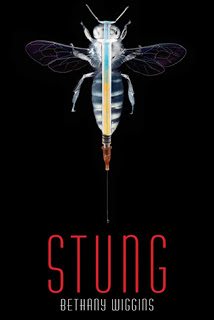
Bethany Wiggins
Walker’s Childrens
April 2nd, 2013
Order Now
I recently served as the research assistant to a professor at my law school who wrote a comical presentation on zombies and tax law. So I know my zombies. And technically, this isn’t a zombie book. It’s more like 28 Days Later and the rage virus, really. Fast, crazed humans who feast on one another when they have the chance. Creepy stuff, no doubt. But zombie lit? Maybe. If we give it a broad definition.
In Stung, our heroine Fiona Tarsis – known affectionately as Fo – finds herself waking up in her own bed. The problem is that this is not the same house she remembered and she is not the same person. When she last went to sleep everything was normal and she was thirteen years old. Now? The world is a veritable wasteland and filled with deadly, ravenous ‘beasts’ that were once human. And she is several years older with a strange tattoo with ten marks on her hand.
Stung throws the reader into the action immediately as Fiona is forced to race from her home and flee into a drastically changed world. People like her – people with the ‘mark of the beast’ on their hands – are feared and they are all a bit crazy. The more marks the crazier they are… and ten is the most anyone can have. Eventually she is captured by the militia outside a walled city were only certain people are allowed to take refuge. She is reunited with an old neighbor – Bowen – who takes a chance on her and vows to protect her. Not just from the beasts that roam the world now but from others, too. See, in this world, women are a commodity and if he doesn’t protect her she’ll never live to see the safety of the city or the lab that seeks to experiment on her in order to find a cure. And while serving as some crazy scientists’ guinea pig doesn’t sound that doesn’t seem like the greatest future, in this world, it’s really the safest option.
But even that might not be safe.
It’s certainly an interesting angle that Wiggins took with this dystopian future. In Stung, the world has changed drastically and quickly. And it all began with the impending extension of the honey bees and science’s desires to stop it at all costs. Unfortunately the cost turned out to be higher than they ever anticipated. The virus that makes everyone go crazy is spread by the vaccine to a flu that was caused by the sting of genetically engineered honey bees. The plan was for them to survive and thrive to keep on pollinating. Unfortunately the pesticide they then used to kill the bees did just that – plus it killed most of the livestock, birds, and plants. Even some people. Viruses caused by vaccines aren’t new but the bee angle was a nice twist. It adds a little environmentalist flare to it all and gets kids thinking about the repercussions of genetic engineering.
I do question, though, just how everything changed so quickly. The world that Wiggins describes is a far departure from our own. And we know from what Fiona remembers and what she looks like now that not that much time has passed.
Anyway, it’s definitely a book worth reading. And I really like that it actually ended. A lot of YA books these days push really hard to leave things open for a sequel or are commissioned as a series (usually a trilogy). They live it open a bit for a sequel but it’s really just a small bit. The bulk of the story ends and there is a a good resolution. They could make a sequel but… I don’t know. We need more good standalone books these days.